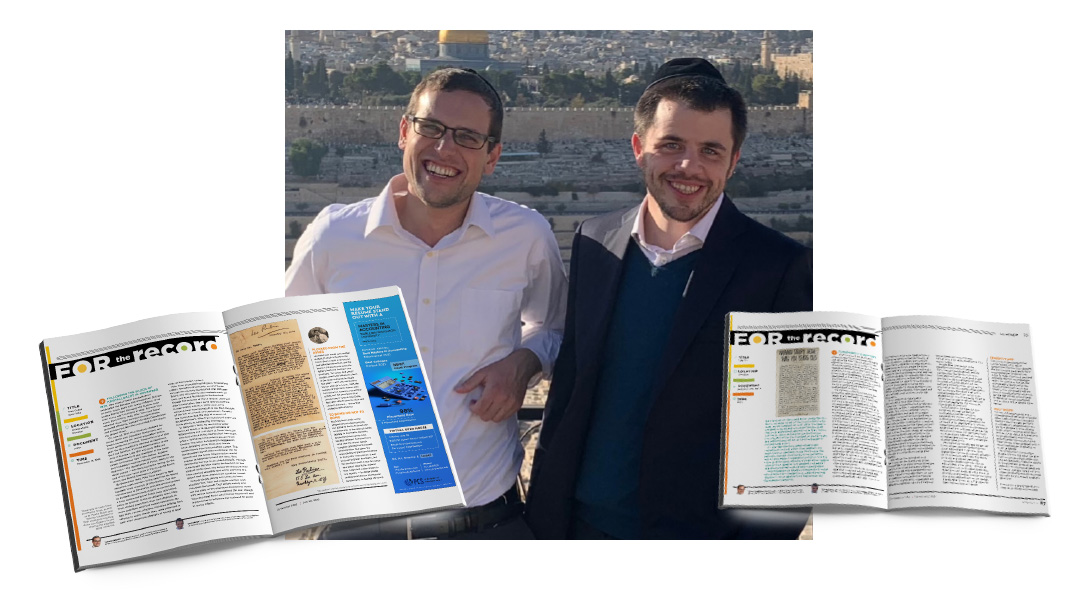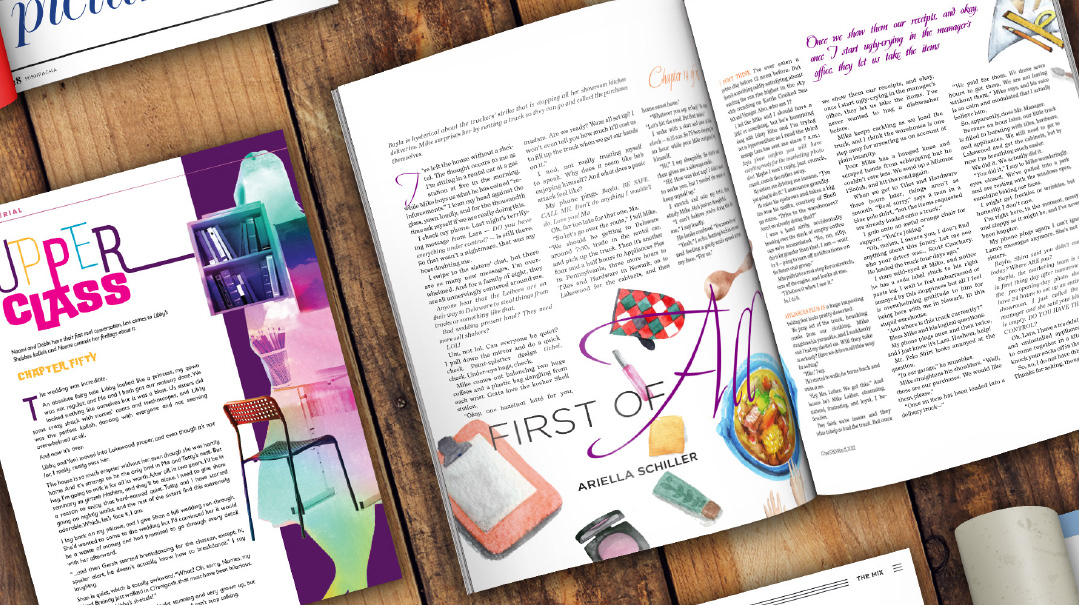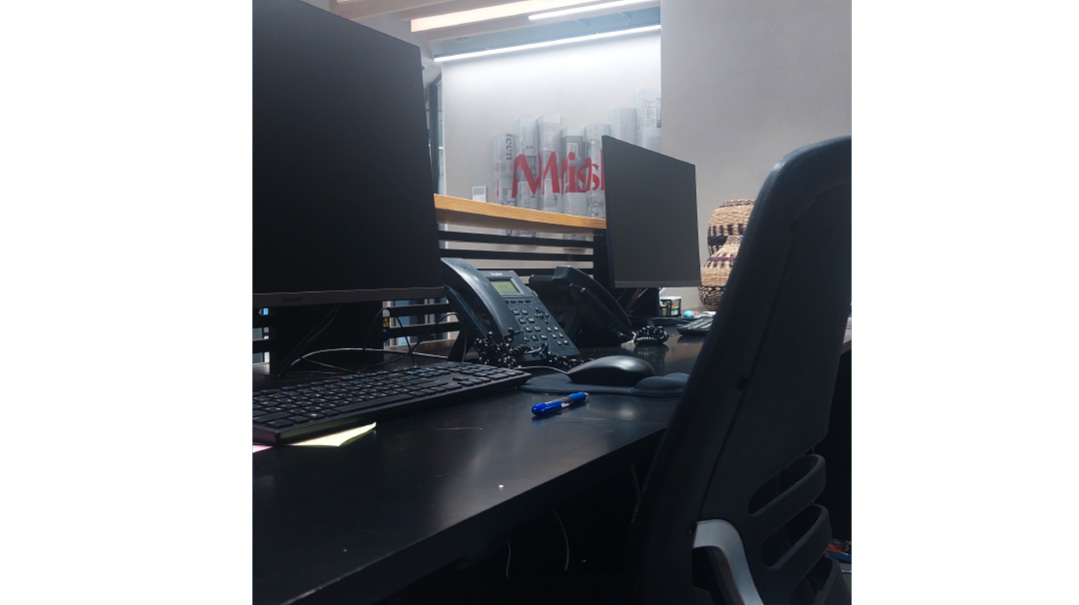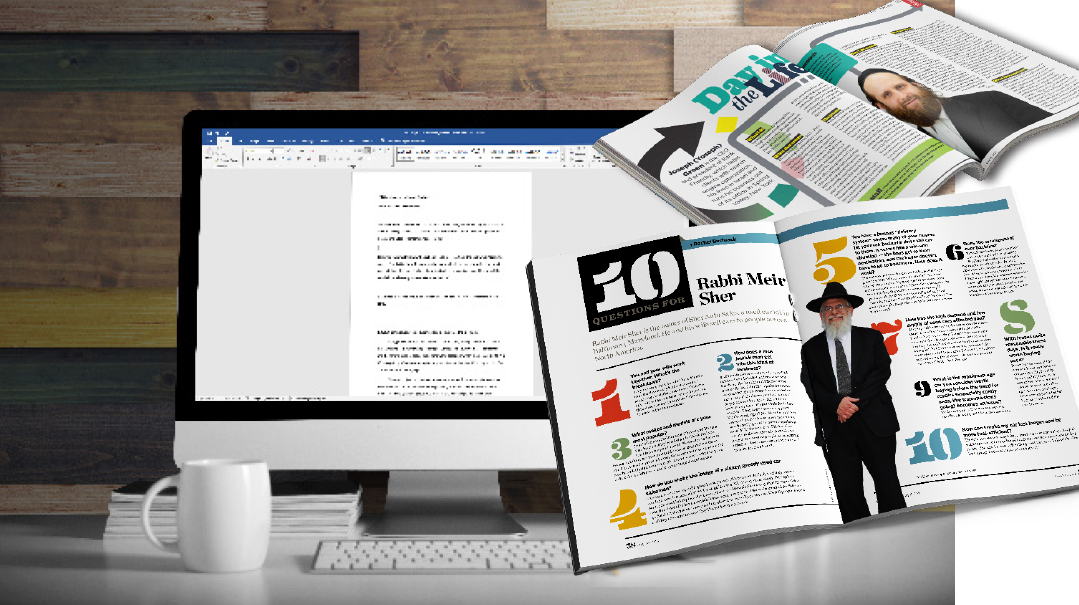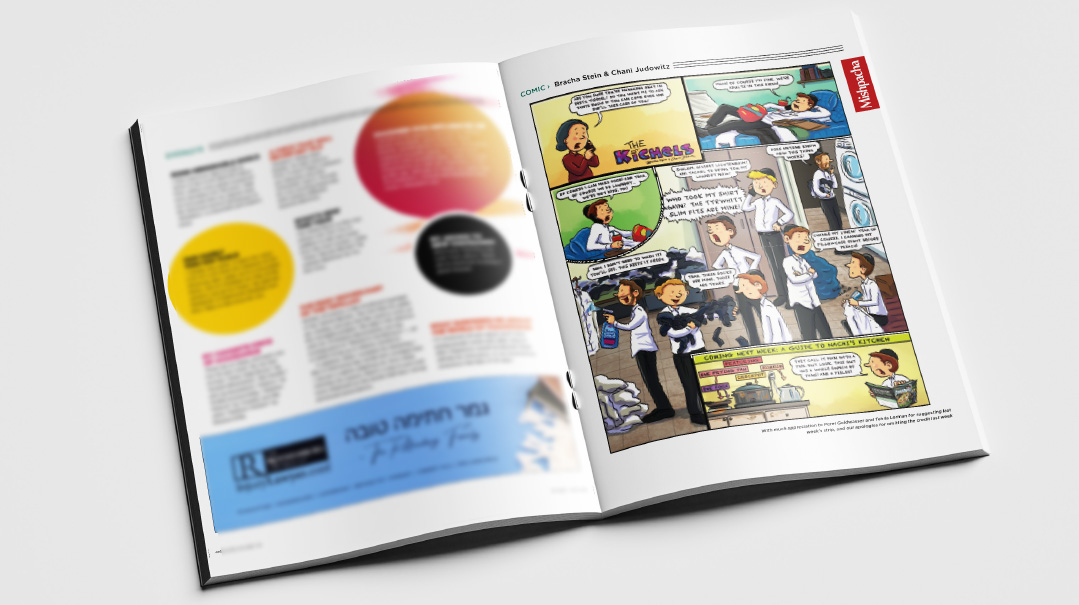20 Questions for… Chava Lipszyc
| November 26, 2024Chava works as Production Manager, making the magic happen weekly for eager readers
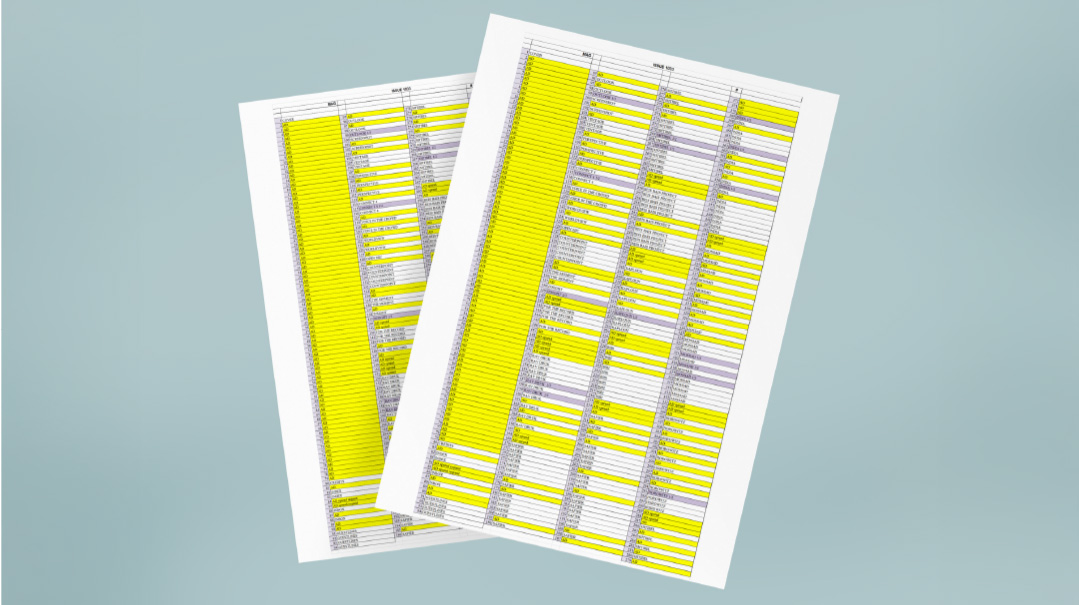
Chava grew up in Argentina and moved to the Old City of Jerusalem upon her marriage. She worked for the Kosel Tunnel Tours, a job she describes as “almost magical,” until she was recruited to Mishpacha, where she works as Production Manager, making the magic happen weekly for eager readers.
My ideal work environment
I’m happiest with the buzz of other people around me, but not on Monday, closing day, when I need to work without people talking and interrupting. I don’t need anything special in my office, besides around five staplers on my desk, because they walk, and we need them a lot.
Deadlines make me
I usually make the deadlines! My rule is: all content not related to current events has to be in by Wednesday, so that it’s edited and proofread before Shabbos. This way, on Sunday and Monday the editors can work on the current affairs sections. I explain this to the writers, and for the next few weeks they send their work in nicely on schedule. Eventually, they slip back to their normal, last-minute habits.
The professional accomplishment I’m proudest of
When I began working here, they never started designing a piece before they had the text. I knew right away that I would change this. I give the art director all the information I have, and he designs the opening page with a note “Title here” in place of the actual title. When the text is ready, any designer can insert it into the waiting design.
I also changed the closing schedule for the Yom Tov issues in two ways. We now close the magazine on the day before it goes to print. This means we leave the office around 12 a.m. instead of 4 a.m. We also close the issue before a major Yom Tov issue a day earlier than usual, to give more time for the mega issue.
The best piece of advice I got was
Don’t talk when you are under pressure. If something goes wrong, or someone messes up, let it go. The next day, you can have the necessary discussion, calmly.
1
How did you join Mishpacha?
I started working at Mishpacha nearly eight years ago in the Spanish department, which worked out of the Israel office. After I’d spent a few months there, Hila Aftergut, the COO, asked me to switch to the English department to work on the main magazine production. This transition happened just before Pesach, so I began learning my new role during an especially busy period.
2
Can you describe what your job involves?
Everyone asks me the same question, but there isn’t just one answer like “doing graphics” or “working as a secretary.” Producing a magazine means overseeing the entire process of putting it together, which involves many stages before it goes to print. The production department is sometimes referred to as the “nucleus” of the magazine operations, from where everything is tracked and controlled. This includes setting deadlines, following up with the writers to ensure materials are submitted, sending content for editing, proofreading, and graphic design, and overseeing the task list and priorities for those departments in sync with the print schedule, sourcing photos and arranging photo shoots, sending material to the rabbinical board to approve, creating a magazine grid, and lots more.
Once everything is laid out, we repeat the editorial review and proofreading stages, to catch any missed details, before sending it off to print. This takes place just prior to closing, and requires careful orchestration to move things to the right person at the right time, and to correct any errors that are flagged at this stage.
Along the way, I handle other technical details that keep things running smoothly for the staff: troubleshooting computer issues, putting drinks in the fridge, and making sure food is ordered for closing days.
3
How do you cope with the pressure?
I’m used to the pressure — closing the weekly magazine has become part of my regular schedule, like preparing for Shabbos. On Sunday and Monday, we work intensely to complete the magazine, and then on Tuesday, my week “officially” begins on a positive note (with a morning Zumba session!).
The real pressure comes before Yom Tov, but for some reason, it makes me feel even calmer. People often ask me how I stay so calm, but I find that staying calm helps me think clearly, prioritize, and handle each situation as it comes up.
I reached this understanding after several big closings and a number of mistakes, when I realized that there is a time Hashem has designated for the magazine to close (eis laledes v’eis lamus). So often, we work hard and press everyone to finish early, and then, just when we think we’re almost done — oops! — we discover that an incorrect text was processed at the last minute, and everything has to be changed. Once, a singer told us at the last minute that he wouldn’t approve his piece for print without reviewing it. Since he doesn’t understand English, we ended up doing an oral translation over the phone for over an hour to save the cover story.
And then there are Mondays when you start the day thinking, “This is going to be a looong Monday” — but somehow, Hashem makes kfitzas haderech, and we look at each other, not understanding how we finished so quickly! The most important thing is that everyone should enjoy the closing and that it should be a relaxed process for everyone; this makes for a better product.
4
What skills do you need for your role?
You have to be organized and nice to people — but also tough, because you need to be firm and take responsibility.
5
What’s the hardest part of your job?
The work becomes challenging when there’s a shortage of staff in other departments or new people in the system, and I don’t have the capacity to cover for them. Since there’s a deadline for going to print, I’m left with two options: Either skip some steps in the process (which usually isn’t possible, because you still need to send something to print) or take a deep breath and help them with whatever I can.
6
Tell us about a near fiasco.
The magazine sold in Israel has a different barcode from the one sold in the US. One Rosh Hashanah magazine was completely finished, closed and sent for approval, but the designer who added the spine used the cover and spine from the Israel edition on the magazine for the US. The covers were identical, and I didn’t catch that the barcode was wrong. That means that the magazine went to print in America with an Israeli barcode. The US team had to contact every single store to either put the Israeli barcode into their system, or send them a printout of the US barcode to scan.
I’m sure there are many more incidents, and I’m glad I don’t remember them all. But being the final set of eyes means catching everyone else’s mistakes.
7
What do you love about Mishpacha?
There’s a great atmosphere in the office; people are heimish, and during breaks we try to help each other with things like shopping, planning a menu for Yom Tov, recommending recipes, and having meaningful conversations about hashkafah or chinuch. There are very smart people in the office, so there’s always something to learn from everyone.
On a regular day, when there isn’t the lachatz of a closing, Libby Livshin from administration organizes a brachos party for Rosh Chodesh. These parties were started by our previous secretary, Lori Friedman, more than 15 years ago — and they continue to this day. We celebrate every birthday with ice cream or bio-yogurt from the Katsefet ice cream store (which has a branch downstairs in the office building). In short, like any other women’s office, it’s always about food and diets.
I also find that is nice to see the final product — a beautifully finished magazine — after all the hard work.
8
Can you work from home, or do you need to be in the office?
Technically, I can work from home, but it’s not the same since everyone else works in the office, which makes remote work more challenging. Closing the magazine is almost impossible to do from home. Even during the Covid lockdown, I came into the office to close every issue, with a skeleton team: Shana Friedman, two of the proofreaders, and two graphic artists. Family First and Mishpacha Junior worked from home, though.
That Thursday, when schools closed for Covid, we met in the office, closed the week’s magazine early, and figured out how it could work over the lockdown. Until Covid, we used a whiteboard and markers in our production office, but we immediately switched to using Trello for moving the work from one stage to the next.
9
What is a grid, and what does it entail to construct it?
The grid is designed to ensure everyone knows what goes on each page of the magazine so it can be closed and uploaded correctly to the printer. To build the grid, you first need to know how many pages the content and ads will occupy. After that, you can structure it based on the order the editor wants the stories to appear and the requests from clients for their ads. I prepare a grid on Excel with instructions for every page, so everyone knows what goes where. I send it to Nina from the advertising department and she places the ads.
10
Which part of your job did you not anticipate?
To be honest, there are many things I do now that I never thought I would be doing, like fixing the printer or sometimes the computer, and fixing a few graphics mistakes, like wrong page numbers, once the graphics team have left. Production is very dynamic, and somehow, these things just become part of the job.
11
How has your job changed since you came on board?
I’ve been working at Mishpacha for nearly eight years, and as you know, the magazine has changed a lot! The number of pages has increased, and we are always looking for ways to innovate and improve the product. All of these changes have had an impact on my job, the number of hours I put in, and the amount and range of details that I have to stay on top of. Lately, I’ve started helping out with the digital/website department.
12
Which requests do you have to say no to?
When we have passed the printer deadline and any department asks to make changes on errors, like a weak caption or the name of a chassidus spelled wrong in English, I have to say no. By that time, I’m only able to address big mistakes, like a wrong byline or name, and to make changes required by the rabbinical board. It’s hard to say no, because, for the editor, who wants to deliver a great product, it’s difficult to accept these limitations.
13
What are the side perks of your job?
I get to see the magazine before anyone else, stay ahead of all the internal news — like which editor or proofreader’s daughter is getting engaged the next day — receive a free magazine every week, and have the opportunity to speak to many important people from around the world. The Chief Rabbi of Russia was so nice and easy to speak to! And MBD? I admit I saved his WhatsApp message and sent it around to my family. Although my English is not perfect, I don’t get easily intimidated. I’ve learned how to communicate with different types of people. Just for example, US Senators don’t like communicating on WhatsApp. They only answer email.
14
Which time of year do you enjoy the most at Mishpacha?
During the Yom Tov season, there’s always action, new challenges, and the need to keep going. I really enjoy this energy. The hard part is in the summer, when things are calmer but still challenging because we take turns going on vacation, which means closing the magazine with fewer helping hands. On top of that, with the kids at home, we’re getting phone calls every five minutes. In the winter, there’s a similar challenge as people get sick or have to care for their sick children.
15
Do you and your family get feedback?
Not really. I get nice feedback from my family when I’m home early….
16
What’s the biggest challenge you’ve had with a photoshoot?
One of my most challenging photoshoots was with a certain Jewish personality. We scheduled it several times, but he kept canceling at the last minute. However, once he saw the story we had written and approved it, he suddenly became incredibly available. He posed for more than two hours, despite the rain, making sure we got amazing photos.
In some South American countries it can be hard to pay a photographer, because the banks charge a very high percentage on foreign transfers and are hard to work with. I have to work carefully there. In some parts of Europe, the photographers can be hard to get hold of if we are scheduling at the last minute. We pay them as soon as we receive the pictures.
17
How many languages do you speak?
I speak four languages: French, Spanish, English, and Hebrew. Both of my grandfathers are from France, which is why we spoke French at home. My father and mother are from London, and I was born in Argentina, where Spanish is spoken, but English is taught in schools. I polished up my English when I traveled to be with my family in England for Pesach and a few summers. I now live in Eretz Yisrael. Being multilingual is often a huge help when arranging photoshoots or helping communicate with people who come to the office.
18
What’s a memorable late-breaking story that caused the whole magazine to be adjusted on closing day?
Once, the rav canceled the cover story just as I was about to approve it. This happened at the last minute, between 9 and 10 p.m. We had to rearrange the magazine pages, bring in a new story to fill the space, and design a new cover.
Rav Gershon Edelstein passed away on a Tuesday morning, when the magazine was already printed. We stopped the process of packaging the magazines, and prepared a 16-page supplement. Mishpacha does not prepare obituaries in advance, so this involved finding pictures, translating articles from Hebrew, and writers preparing fresh articles.
Once, when another prominent rav passed away on a Monday, I had to send the keys to my house with a courier to one of my neighbors so my kids could get in.
19
Which part of the magazine gives you the most nachas to see?
As is true for everything in life, the more effort you put in, the more nachas you get. When I work hard to get great photos or tackle challenges in the graphics, I enjoy the visual outcome of the magazine even more. Sourcing photos is my job, and obviously every picture needs full permission to be published. When I can’t get that permission, we can’t use the pictures and have to use an extra teaser instead, but when I can get them, it gives me satisfaction.
20
If you weren’t running Mishpacha Production, what would you be doing?
I enjoy working with people, so I believe I’d be in a role that involves working closely with others. In Argentina I taught Chumash and Yahadus in high school, and also managed the kosher grocery which was housed under the school building. When I first came to live in Yerushalayim, I managed the customer service office of the Kosel Tunnel Tours and Kosel Heritage events. I could run any busy heimishe office.
Questions for 20 Years
Coming up:
Rachel Bachrach, Deputy Editor
Libby Livshin, Administration
Send your questions to 20years@mishpacha.com
(Originally featured in Mishpacha, Issue 1038)
Oops! We could not locate your form.

